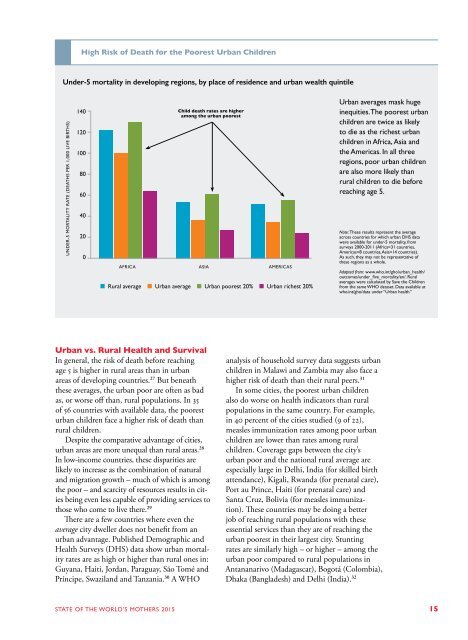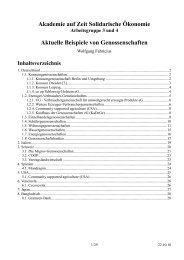sowm_2015__int__africa_full_report_low_res
sowm_2015__int__africa_full_report_low_res
sowm_2015__int__africa_full_report_low_res
Create successful ePaper yourself
Turn your PDF publications into a flip-book with our unique Google optimized e-Paper software.
High Risk of Death for the Poo<strong>res</strong>t Urban Children<br />
Under-5 mortality in developing regions, by place of <strong>res</strong>idence and urban wealth qu<strong>int</strong>ile<br />
UNDER-5 MORTALITY RATE (DEATHS PER 1,000 LIVE BIRTHS)<br />
140<br />
120<br />
100<br />
80<br />
60<br />
40<br />
20<br />
0<br />
Child death rates are higher<br />
among the urban poo<strong>res</strong>t<br />
AFRICA ASIA AMERICAS<br />
■ Rural average ■ Urban average ■ Urban poo<strong>res</strong>t 20% ■ Urban richest 20%<br />
Urban averages mask huge<br />
inequities. The poo<strong>res</strong>t urban<br />
children are twice as likely<br />
to die as the richest urban<br />
children in Africa, Asia and<br />
the Americas. In all three<br />
regions, poor urban children<br />
are also more likely than<br />
rural children to die before<br />
reaching age 5.<br />
Note: These <strong>res</strong>ults rep<strong>res</strong>ent the average<br />
across countries for which urban DHS data<br />
were available for under-5 mortality, from<br />
surveys 2000-2011 (Africa=31 countries,<br />
Americas=8 countries, Asia=14 countries).<br />
As such, they may not be rep<strong>res</strong>entative of<br />
these regions as a whole.<br />
Adapted from: www.who.<strong>int</strong>/gho/urban_health/<br />
outcomes/under_five_mortality/en/. Rural<br />
averages were calculated by Save the Children<br />
from the same WHO dataset. Data available at<br />
who.<strong>int</strong>/gho/data under “Urban health.”<br />
Urban vs. Rural Health and Survival<br />
In general, the risk of death before reaching<br />
age 5 is higher in rural areas than in urban<br />
areas of developing countries. 27 But beneath<br />
these averages, the urban poor are often as bad<br />
as, or worse off than, rural populations. In 35<br />
of 56 countries with available data, the poo<strong>res</strong>t<br />
urban children face a higher risk of death than<br />
rural children.<br />
Despite the comparative advantage of cities,<br />
urban areas are more unequal than rural areas. 28<br />
In <strong>low</strong>-income countries, these disparities are<br />
likely to increase as the combination of natural<br />
and migration growth – much of which is among<br />
the poor – and scarcity of <strong>res</strong>ources <strong>res</strong>ults in cities<br />
being even less capable of providing services to<br />
those who come to live there. 29<br />
There are a few countries where even the<br />
average city dweller does not benefit from an<br />
urban advantage. Published Demographic and<br />
Health Surveys (DHS) data show urban mortality<br />
rates are as high or higher than rural ones in:<br />
Guyana, Haiti, Jordan, Paraguay, São Tomé and<br />
Príncipe, Swaziland and Tanzania. 30 A WHO<br />
analysis of household survey data suggests urban<br />
children in Malawi and Zambia may also face a<br />
higher risk of death than their rural peers. 31<br />
In some cities, the poo<strong>res</strong>t urban children<br />
also do worse on health indicators than rural<br />
populations in the same country. For example,<br />
in 40 percent of the cities studied (9 of 22),<br />
measles immunization rates among poor urban<br />
children are <strong>low</strong>er than rates among rural<br />
children. Coverage gaps between the city’s<br />
urban poor and the national rural average are<br />
especially large in Delhi, India (for skilled birth<br />
attendance), Kigali, Rwanda (for prenatal care),<br />
Port au Prince, Haiti (for prenatal care) and<br />
Santa Cruz, Bolivia (for measles immunization).<br />
These countries may be doing a better<br />
job of reaching rural populations with these<br />
essential services than they are of reaching the<br />
urban poo<strong>res</strong>t in their largest city. Stunting<br />
rates are similarly high – or higher – among the<br />
urban poor compared to rural populations in<br />
Antananarivo (Madagascar), Bogotá (Colombia),<br />
Dhaka (Bangladesh) and Delhi (India). 32<br />
STATE OF THE WORLD’S MOTHERS <strong>2015</strong> 15




